
Saint Helena is a British overseas territory located in the South Atlantic Ocean. It is a remote volcanic tropical island 1,950 km (1,210 mi) west of the coast of south-western Africa, and 4,000 km (2,500 mi) east of Rio de Janeiro in South America. It is one of three constituent parts of the British Overseas Territory of Saint Helena, Ascension and Tristan da Cunha.
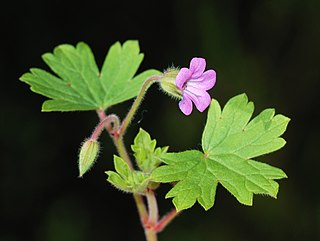
Geraniaceae is a family of flowering plants placed in the order Geraniales. The family name is derived from the genus Geranium. The family includes both the genus Geranium and the garden plants called geraniums, which modern botany classifies as genus Pelargonium, along with other related genera.

Pelargonium is a genus of flowering plants that includes about 280 species of perennials, succulents, and shrubs, commonly called geraniums, pelargoniums, or storksbills. Geranium is also the botanical name and common name of a separate genus of related plants, also known as cranesbills. Both genera belong to the family Geraniaceae. Carl Linnaeus originally included all the species in one genus, Geranium, and they were later separated into two genera by Charles Louis L'Héritier de Brutelle in 1789.
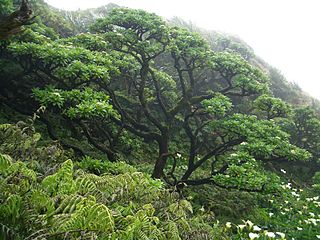
The Saint Helena scrub and woodlands ecoregion covers the volcanic island of Saint Helena in the South Atlantic Ocean. The island's remote location gave rise to many endemic species. First discovered and settled in the 1500s, the island has been degraded by human activities. Most of its native habitat has been destroyed, and many of its unique plants and animals are extinct or endangered.

The Saint Helena olive is an extinct species of flowering plant. It is the only member of the genus Nesiota. It was endemic to the island of Saint Helena in the South Atlantic Ocean. Despite its name, it is unrelated to the true olive, but is instead a member of the family Rhamnaceae, the family which contains buckthorns and jujube. The last remaining tree in the wild died in 1994, and the last remaining individual in cultivation died in December 2003, despite conservation efforts. It is thus a prime example of recent plant extinction. The Saint Helena olive belongs to the tribe Phyliceae, which are mostly endemic to Southern Africa.

The flora of Saint Helena, an isolated island in the South Atlantic Ocean, is exceptional in its high level of endemism and the severe threats facing the survival of the flora. In phytogeography, it is in the phytochorion St. Helena and Ascension Region of the African Subkingdom, in the Paleotropical Kingdom.

Trochetiopsis ebenus, the dwarf ebony or Saint Helena ebony, is a species of flowering plant that is endemic to the island of Saint Helena in the southern Atlantic Ocean. It is not related to the ebony of commerce, but is instead a member of the mallow family, Malvaceae. Saint Helena ebony is now critically endangered in the wild, being reduced to two wild individuals on a cliff, but old roots are sometimes found washed out of eroding slopes. These are collected on the island a used for inlay work, an important craft on Saint Helena. A related species, Trochetiopsis melanoxylon is now completely extinct.
Heliotropium pannifolium, the Saint Helena heliotrope, is now extinct but was formerly a hairy-leaved small shrub up to 1 m in height. it was only seen once, by the explorer W. Burchell in Broad Gut, Saint Helena and has never been seen again. Human impact on the island of Saint Helena was severe and the Saint Helena heliotrope is one of several extinct plants from that island.
Saint Helena, Ascension Island and Tristan da Cunha, as well the other uninhabited islands nearby, are a haven for wildlife in the middle of the Atlantic Ocean. The islands are or were home to much endemic flora and fauna, especially invertebrates, and many endemic fish species are found in the reef ecosystems off the islands. The islands have been identified by BirdLife International as Important Bird Areas for both their endemic landbirds and breeding seabirds.
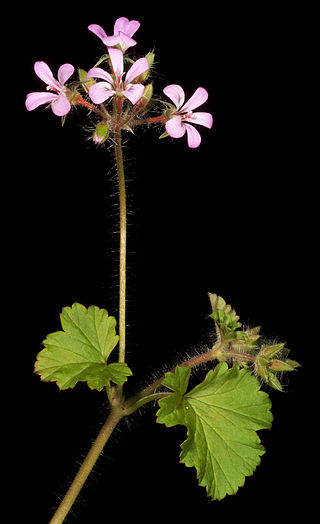
Pelargonium littorale is a species of Pelargonium found within the southwest botanical province of Australia.

Prosperous Bay Plain is an area on the eastern coast of Saint Helena, a British island territory in the South Atlantic Ocean. It is the site of the Saint Helena Airport, and is notable for its high invertebrate biodiversity.

Pelargonium drummondii is a species of Pelargonium found around the southern coasts of Western Australia.
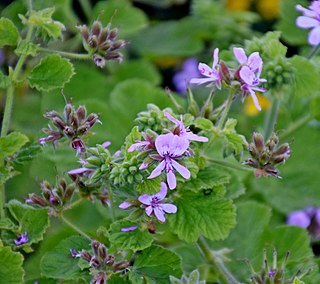
Pelargonium vitifolium is a species of geranium known by the common name grapeleaf geranium. It is a shrub endemic to the Cape Provinces of South Africa. it is a commonly grown ornamental plant. This is a mostly erect, branching shrub approaching one meter in maximum height. The stems are soft and coated in soft hairs when young and become more woody with age. The glandular, stiffly-hairy aromatic leaves are about 6 centimeters long and 8 wide, divided into 5 or 7 toothed, heart-shaped lobes. The inflorescence is a dense umbel of several flowers with five petals each around a centimeter long. The flowers are pink with purplish markings.

Pelargonium sp. Striatellum, commonly known as Omeo stork's-bill, is an undescribed species of Pelargonium that is endemic to Australia. It is listed as "endangered" under the Environment Protection and Biodiversity Conservation Act, "endangered" in New South Wales and "vulnerable" in Victoria. It exists in five known locations; four in New South Wales and another in Victoria. Other populations may exist undiscovered on private land.

Pelargonium australe is a perennial herb that is endemic to Australia, and found in all states except the Northern Territory. Common names include native storksbill, wild geranium and austral storksbill. The species grows to 50 cm high and has leaves with 5 to 7 lobes. Umbels of 4 to 12 flowers appear between October and March in the species' native range. These are pink with darker markings.
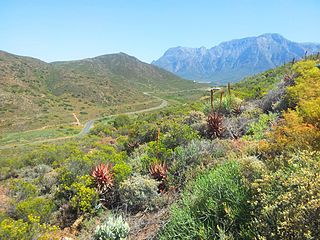
Robertson Karoo is a semi-arid vegetation type, restricted to sections of the Breede River Valley, Western Cape Province, South Africa. It is a subtype of Succulent Karoo and is characterised by the dominance of succulent plant species, and by several endemic plants and animals.

Crassula cotyledonis is a succulent plant endemic to the arid Namaqualand and Karoo regions of South Africa.

Pelargonium cordifolium is a plant endemic to the fynbos region of the Southern Cape of South Africa.

Pelargonium inquinans, the scarlet geranium, is a species of plant in the genus Pelargonium. It is a shrub endemic to South Africa, ranging from Mpumalanga to KwaZulu-Natal and Eastern Cape provinces. It is one of the ancestors of the hybrid line of horticultural pelargoniums, referred to as the zonal group. They can easily be propagated by seeds and cuttings.

















